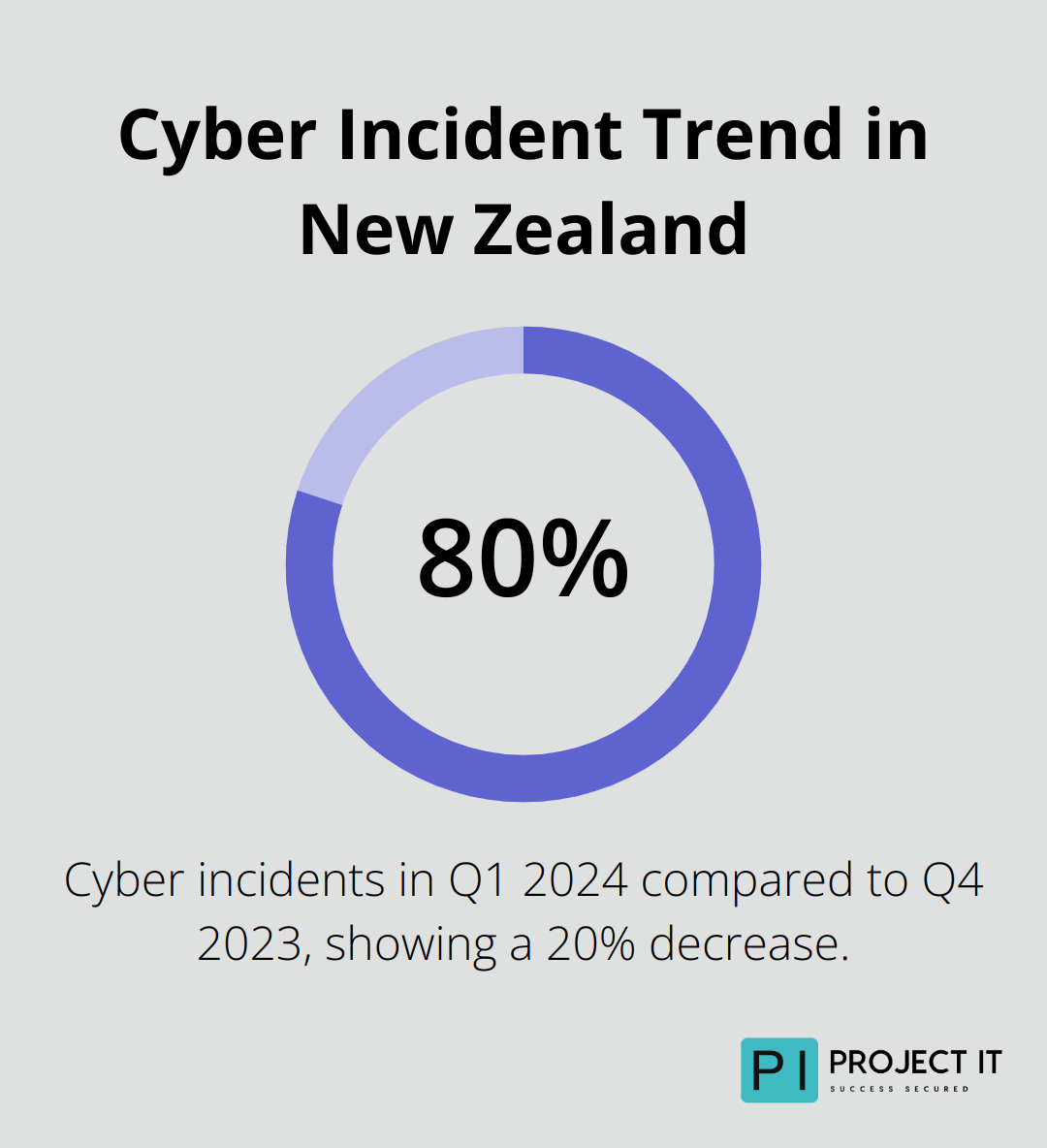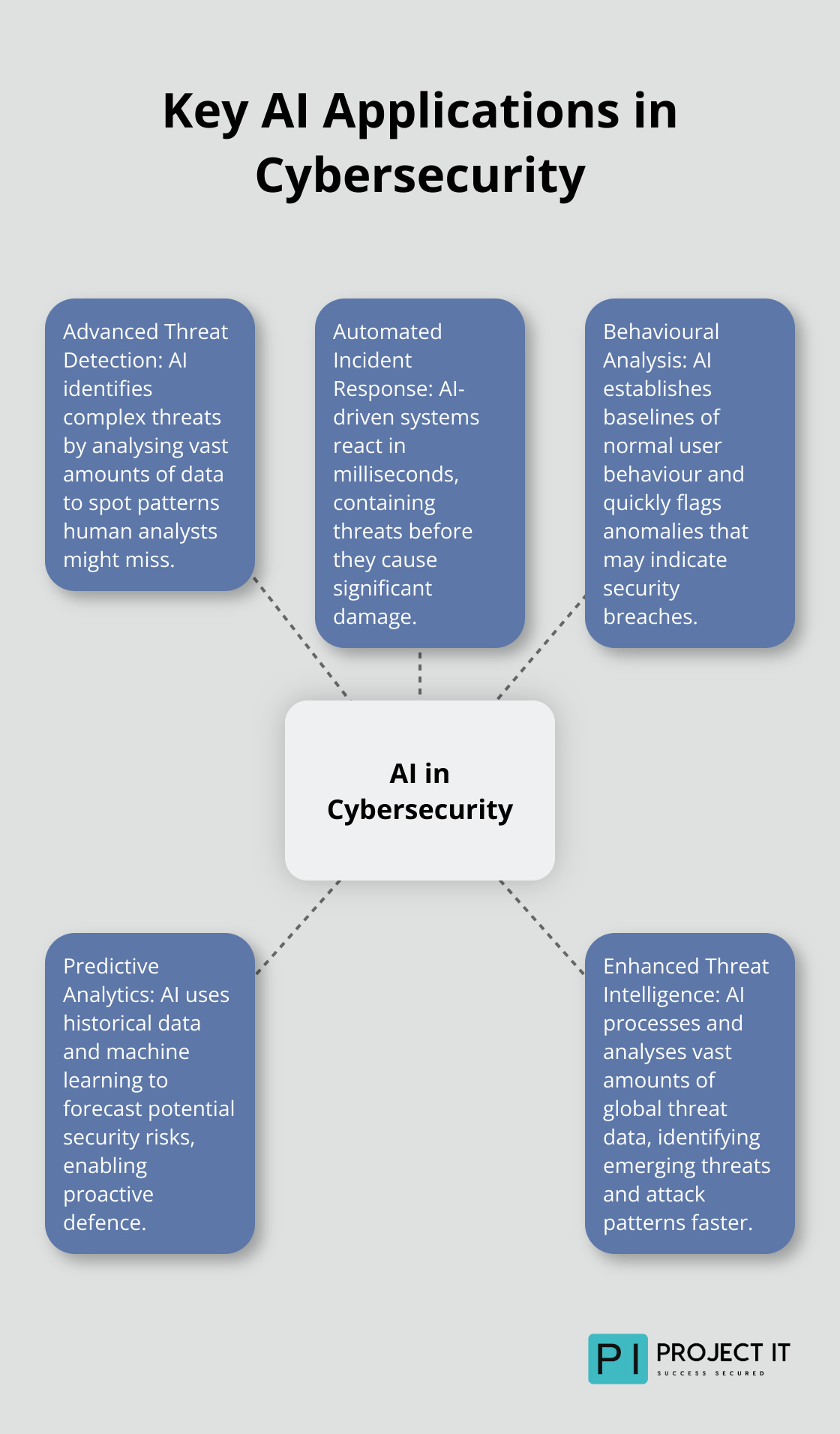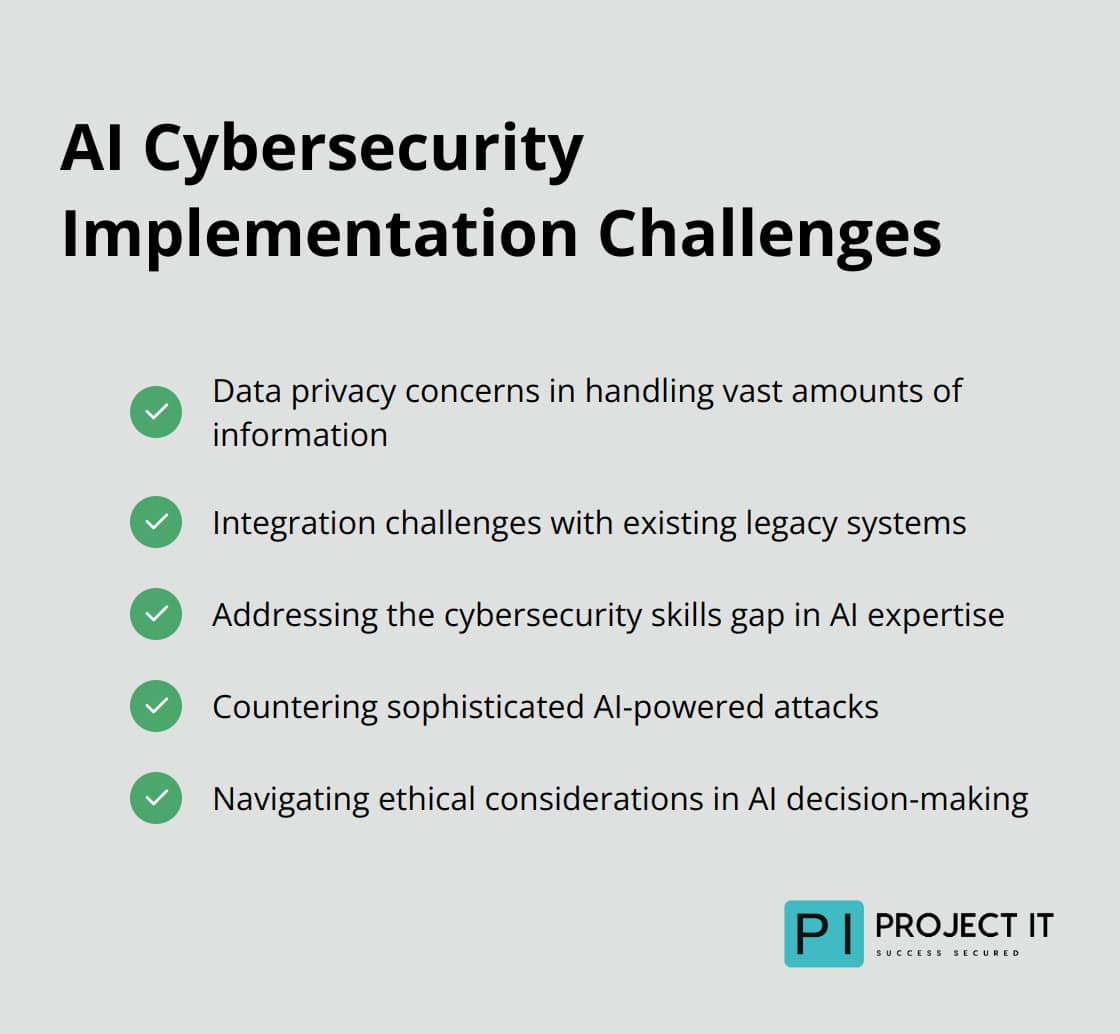Cyber threats in New Zealand are evolving at an alarming rate, outpacing traditional security measures. At Project IT, we’ve witnessed firsthand how AI in cybersecurity is transforming the landscape, offering powerful new tools to combat these threats.
AI-powered solutions are revolutionising threat detection, incident response, and predictive analytics, providing a robust defence against sophisticated attacks. This blog post explores how AI is reshaping cybersecurity in New Zealand and what it means for businesses and individuals alike.
AI’s Impact on New Zealand’s Cybersecurity Landscape
The Growing Cyber Threat in New Zealand
New Zealand’s cybersecurity landscape faces rapid evolution. In Q1 2024, CERT NZ responded to 1,537 incidents, down 20% from Q4 2023. This change in cyber threats exposes the limitations of traditional cybersecurity methods and underscores the need for more advanced solutions.

Limitations of Traditional Cybersecurity
Traditional cybersecurity methods often rely on signature-based detection, which fails to keep pace with the ever-changing nature of cyber threats. These methods react only to known threats and often miss new, sophisticated attacks. This leaves organisations vulnerable to zero-day exploits and advanced persistent threats.
The sheer volume of data that requires analysis for potential threats overwhelms human analysts. A PwC New Zealand survey revealed that 45% of businesses encountered ransomware, indicating the prevalence of complex attacks that traditional methods struggle to prevent.
AI: The Game-Changer in Cybersecurity
Artificial Intelligence (AI) revolutionises cybersecurity by addressing these limitations. AI-powered solutions analyse vast amounts of data in real-time, identifying patterns and anomalies that human analysts might miss. This capability proves crucial in today’s threat landscape, where attacks become increasingly sophisticated and frequent.
Real-World Applications of AI in Cybersecurity
Threat Detection and Prevention
AI algorithms use machine learning models to continuously improve threat detection capabilities for responding to evolving threats. For instance, AI-driven systems analyse network traffic patterns to detect and block potential DDoS attacks before they cause significant damage.
Automated Incident Response
AI transforms incident response. Automated systems now detect and respond to threats in real-time, significantly reducing the time between detection and mitigation. IBM reports that companies utilising AI in their cybersecurity strategy can reduce the costs of a data breach by an average of $1.5 million.
Behavioural Analysis: A New Frontier
AI makes a significant impact in behavioural analysis. By establishing baselines of normal user and system behaviour, AI quickly identifies and flags anomalies that may indicate a security breach. This approach proves particularly effective against insider threats, which traditional methods often struggle to detect.
As cyber threats continue to evolve, the role of AI in cybersecurity will expand. The integration of AI-powered solutions into comprehensive security offerings helps New Zealand businesses stay one step ahead of cyber-criminals and protect their valuable digital assets. The next chapter will explore the key AI applications in cybersecurity, detailing how these technologies enhance threat detection, automate incident response, and enable predictive analytics for proactive security measures.
AI’s Key Cybersecurity Applications
AI transforms cybersecurity in New Zealand. Its applications span threat detection, incident response, behavioural analysis, and predictive analytics. This chapter explores how AI-driven solutions protect businesses from evolving cyber threats.
Advanced Threat Detection
AI identifies complex threats with remarkable efficiency. Machine learning algorithms analyse vast amounts of data to spot patterns human analysts often miss. AI-powered systems detect subtle indicators of potential data breaches, such as unusual login attempts or unexpected data transfers.
Automated Incident Response
In threat detection, every second counts. AI-driven incident response systems react in milliseconds, containing threats before they cause significant damage. These systems automatically isolate affected systems, revoke user access, and initiate data backups.
Behavioural Analysis for Insider Threats
AI excels at detecting insider threats through behavioural analysis. It establishes baselines of normal user behaviour and quickly flags anomalies that may indicate a security breach or malicious insider activity.
AI’s ability to continuously learn and adapt makes it particularly effective against evolving insider threats. As attack patterns change, AI systems update their detection models, staying ahead of potential threats.
Predictive Analytics for Proactive Security
AI doesn’t just react to threats; it predicts them. Predictive analytics use historical data and machine learning to forecast potential security risks. This proactive approach allows organisations to strengthen their defences before attacks occur.
For example, AI systems analyse patterns in previous attacks to predict future vulnerabilities. They also identify high-risk users or systems that require additional security measures. This predictive capability transforms cybersecurity from a reactive to a proactive discipline.
AI-Enhanced Threat Intelligence
AI enhances threat intelligence by processing and analysing vast amounts of global threat data. It identifies emerging threats and attack patterns faster than traditional methods. This real-time intelligence allows organisations to update their defences swiftly.
AI-powered threat intelligence platforms correlate data from multiple sources, providing a comprehensive view of the threat landscape. They also automate the process of threat prioritisation, helping security teams focus on the most critical risks.

The integration of AI in these key areas of cybersecurity marks a significant shift in how organisations approach digital security. As we move forward, the next chapter will explore the challenges and considerations that come with implementing AI in cybersecurity, including data privacy concerns and the potential for AI-powered attacks.
Navigating AI Cybersecurity Challenges
Data Privacy in the AI Era
AI systems require vast amounts of data to function effectively, which raises concerns about data privacy and protection. The Privacy Act 2020 in New Zealand applies whenever you collect, use, or share data for AI tools. Organisations must ensure their AI systems comply with these regulations while still leveraging the power of big data analytics.
Companies should implement data anonymisation techniques and strict access controls. Regular audits of AI systems can help identify potential privacy vulnerabilities. It’s also important to be transparent with customers about how their data is used in AI-powered security systems.
Integration with Legacy Systems
Many organisations face difficulties integrating AI solutions with their existing IT infrastructure. Legacy systems often lack the necessary interfaces or data formats for smooth AI integration. This can create inefficiencies and potential security gaps.
Businesses should conduct thorough assessments of their current systems before implementing AI solutions. A gradual integration (starting with non-critical systems) can help identify and resolve compatibility issues early. Cloud-based AI solutions can also offer a more flexible approach to integration, allowing organisations to scale their AI capabilities as needed.
Addressing the AI Cybersecurity Skills Gap
The demand for professionals with expertise in both AI and cybersecurity significantly outstrips the supply. The New Zealand Digital Skills Forum reports that the country faces a significant shortage of skilled IT professionals, with cybersecurity roles being particularly hard to fill.
Organisations can address this gap by investing in training programmes for existing staff and partnering with educational institutions to develop relevant curricula. Managed service providers (like Project IT) can also fill this gap, offering expertise and ongoing support in AI-driven cybersecurity solutions.
Countering AI-Powered Attacks
While AI enhances cybersecurity defences, it also empowers attackers with more sophisticated tools. AI-powered attacks can include automated phishing email campaigns, malware distribution, credit card fraud, insurance fraud, and generating deepfakes.
To counter this threat, organisations must continuously update and refine their AI security models. This includes regular penetration testing using AI-powered tools to identify potential weaknesses before attackers can exploit them. Collaboration within the cybersecurity community is also important, sharing threat intelligence to stay ahead of evolving AI-driven attacks.
Ethical Considerations in AI Cybersecurity
The use of AI in cybersecurity raises ethical questions about privacy, autonomy, and decision-making. Organisations must consider the ethical implications of their AI systems (e.g., potential biases in algorithms or the extent of autonomous decision-making).
Developing clear ethical guidelines for AI use in cybersecurity is essential. This includes establishing oversight mechanisms, ensuring transparency in AI decision-making processes, and regularly reviewing the ethical implications of AI systems as they evolve.

Final Thoughts
AI in cybersecurity has transformed New Zealand’s digital defence landscape. As cyber threats evolve rapidly, AI-powered solutions protect businesses and individuals from sophisticated attacks. The integration of AI in threat detection, incident response, and predictive analytics enhances our ability to safeguard digital assets and maintain data integrity.
The future of AI in cybersecurity appears promising yet challenging. We expect more powerful tools for threat prevention and mitigation, but cyber-criminals will also access sophisticated AI-powered attack methods. Organisations must remain vigilant and adaptable to stay ahead in this evolving threat landscape.
Project IT helps New Zealand businesses navigate this complex cybersecurity landscape. Our team leverages cutting-edge AI technologies to provide comprehensive, tailored cybersecurity solutions (including advanced threat detection and automated incident response). We protect your digital assets against the most sophisticated cyber threats.


